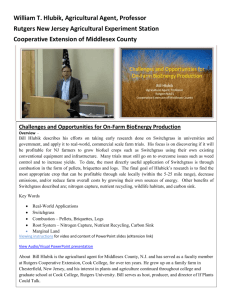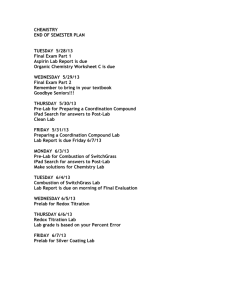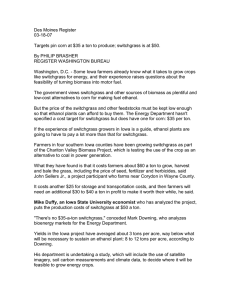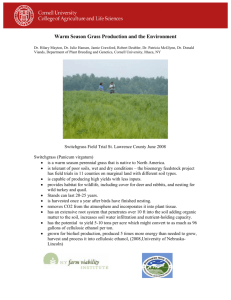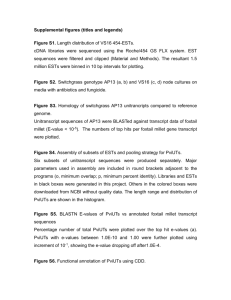Video 6 Learning Module
advertisement
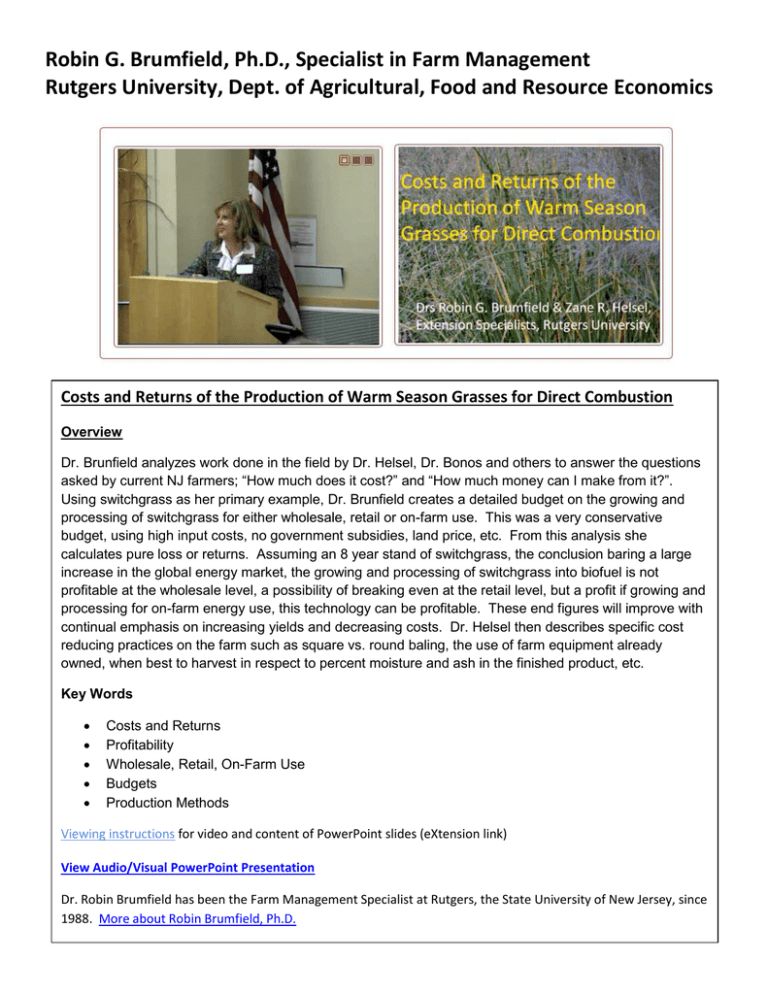
Robin G. Brumfield, Ph.D., Specialist in Farm Management Rutgers University, Dept. of Agricultural, Food and Resource Economics Costs and Returns of the Production of Warm Season Grasses for Direct Combustion Overview Dr. Brunfield analyzes work done in the field by Dr. Helsel, Dr. Bonos and others to answer the questions asked by current NJ farmers; “How much does it cost?” and “How much money can I make from it?”. Using switchgrass as her primary example, Dr. Brunfield creates a detailed budget on the growing and processing of switchgrass for either wholesale, retail or on-farm use. This was a very conservative budget, using high input costs, no government subsidies, land price, etc. From this analysis she calculates pure loss or returns. Assuming an 8 year stand of switchgrass, the conclusion baring a large increase in the global energy market, the growing and processing of switchgrass into biofuel is not profitable at the wholesale level, a possibility of breaking even at the retail level, but a profit if growing and processing for on-farm energy use, this technology can be profitable. These end figures will improve with continual emphasis on increasing yields and decreasing costs. Dr. Helsel then describes specific cost reducing practices on the farm such as square vs. round baling, the use of farm equipment already owned, when best to harvest in respect to percent moisture and ash in the finished product, etc. Key Words Costs and Returns Profitability Wholesale, Retail, On-Farm Use Budgets Production Methods Viewing instructions for video and content of PowerPoint slides (eXtension link) View Audio/Visual PowerPoint Presentation Dr. Robin Brumfield has been the Farm Management Specialist at Rutgers, the State University of New Jersey, since 1988. More about Robin Brumfield, Ph.D. Essays1. As of this year, if a farmer were to grow and process switchgrass for retail or wholesale, he would only “break-even”. What specific actions could he take to increase total profits on both the production and marketing aspects of his operation? In order to increase profits, a farmer must increase yields and decrease costs. Methods to increase yields can be; grow the appropriate crop on the appropriate land, harvest and process at the appropriate times to decrease percent moisture and ash in the finished product, add inputs (if those inputs are not highly expensive), harvest and process using the appropriate methods to increase quality and content and reduce waste and seek help from professional organizations to ensure he is following the appropriate growing techniques and is aware of the latest innovations. To cut costs in his operation, the farmer can; use on-farm equipment and labor in the harvesting and processing stages rather than custom hiring, be sure the crop is healthy and well maintained to avoid pests and diseases which may be costly to eliminate, compare harvesting and processing methods such as square vs. round bales, invest in more efficient burners whether they be bale burners, steamers, pellet burners, etc. and decrease transportation costs by harvesting and processing near the burners. 2. Besides lowering costs and increasing yields, what outside forces that growers have no control over can impact a switchgrass farmer’s profits and losses? Be sure to discus State and Federal legislation and market commodity prices, among others. Some outside forces which may influence the profit or loss of switchgrass production are both the global energy markets and government legislation. If the global market for energy in the form of commodities like oil, natural gas, ethanol, coal, etc. increase sharply, biofuels may not only become profitable for on-farm use, but for retail or wholesale as well. Government tax incentives and subsidies may also push these technologies from “break-even” to “profitable”. In addition, the building of near-by, central processing plants which can be used by any farmer in the community can greatly reduce production costs and decrease transportation costs if located near-by. Multiple Choice1. The yield of non-irrigated switchgrass can range from ______tons/acre. a. 1-3 b. 3-5 c. 5-8 d. 9-12 2. The most expensive production costs for the first seedling year of a switchgrass crop is: a. Land Preparation b. Planting c. Nutrients d. Weed Control 3. As of now, the most profitable way to utilize a crop of switchgrass is: a. On Farm Use b. Retail c. Wholesale d. Form a Co-Op 4. The highest production cost for an established 8 year stand of switchgrass if growing for retail is: a. Establishment b. Nutrients c. Harvesting d. Irrigation 5. Switchgrass has its lowest moisture content in: a. November b. December c. January d. March 6. Currently, the cheapest source of bioenergy is: a. Woodchips b. Switchgrass pellets c. Shelled corn d. Firewood True/False1. The price of switchgrass pellets per ton as of last year was $240 wholesale. False 2. Biofuel crops can be processed into pellets but not briquettes. False 3. Using current production standards and market prices, it is not yet economically viable to grow switchgrass for retail sale. True 4. Over the past three years, the retail cost of wood pellets has decreased. True Fill in the Blank1. According to the study described in the presentation, the total production costs for the first seedling year using mowing rather than herbicides for weed control was $407.90 per acre. 2. The highest cost of switchgrass production is pelletizing.
